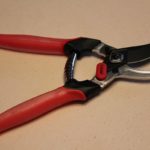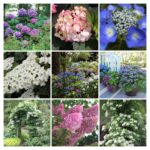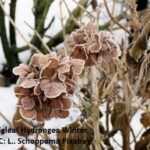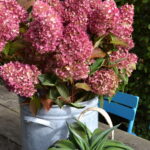I am getting a lot of questions these days about hydrangea leaf spots and unsightly foliage. In most cases, the spots are from an infection by Xanthomonas campestris, or Cercospora which grows from the pathogen Cercospora hydrangeae. I’m also seeing powdery mildew on many other plants, like veggies and perennials that also blemish hydrangeas. You can thank Erysiphe friesii var. friesii (formerly Microsphaera friesii). If you’ve got blemished foliage, a trip to your local extension office can diagnose which it is so you can apply the proper treatment, if at all.
WHERE DO HYDRANGEA LEAF SPOTS COME FROM
The first thing to recognize is that these conditions are predictable. All of them need specific moisture and temperature levels to allow the pathogens to develop and infect your plant. But WHERE DO THEY COME FROM?
There are two main sources of these infections: pathogens that wintered over, or the wind. Know, however, that the infection occurred long before the damage appeared. Those pathogens were hiding in old, diseased leaves that weren’t removed last year, either on your property or a neighbor’s. They could also have been in the mulch, just waiting for conditions to be right to activate and inoculate your plant. Then the wind blew in to help spread the pathogens. Splashing water from rain or overhead irrigation sealed the deal.
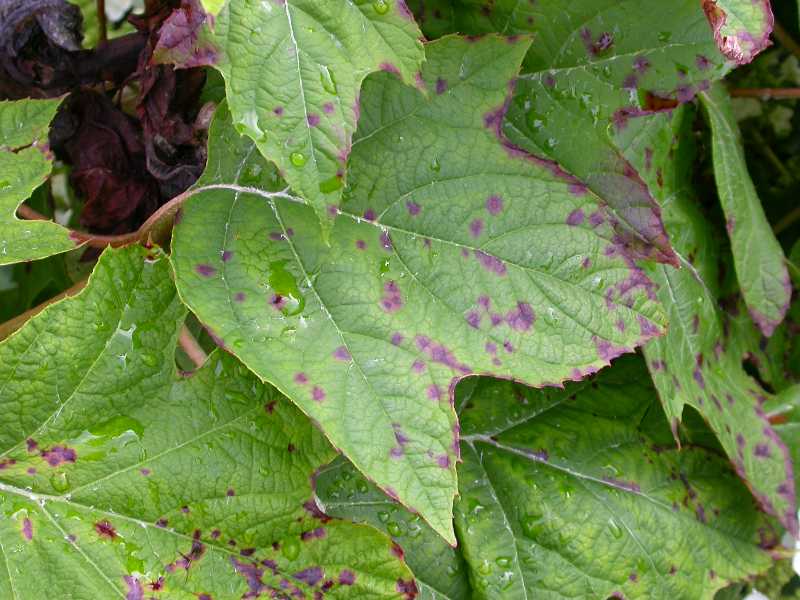
Bacterial leaf spots on hydrangeas are plain ugly.
WHAT TO DO ABOUT HYDRANGEA LEAF SPOTS
As with all fungal infections, you can only treat for future impact. You can’t reverse what has already happened. Sometimes you can remove the infected leaves if it doesn’t make your plant look emaciated. But remember that the leaves are your plant’s food factory so don’t take off too many. Whatever foliage you remove needs to go in the trash, not the compost. You don’t want to have those spores around for subsequent infections when you use your compost.
PREVENTING HYDRANGEA LEAF SPOTS
You can’t change the weather (humid periods, rain, wind), but you can change your watering habits. Soaker hoses or drip irrigation are a good improvement as they will reduce leaf wetness and water splash on your plant. Fall is a good time to map out and install those changes.
Garden sanitation is your next step. Winter temps don’t kill these pathogens so it is imperative that you remove all diseased leaves this year. Don’t slack off at the end of the season when you are least enthusiastic about being outdoors. Make this leaf removal de rigeur each fall. A fastidious clean-up is integral to keeping these infections under control. It’s wise to make a calendar note to remind yourself to clean up fallen leaves later in the season.
TREATING HYDRANGEA LEAF SPOTS
Although it’s late in the season, you may still need to treat your diseased plant. Bacillus subtilis will protect any emerging foliage from becoming infected. The other product I use is Bacillus amyloliquefaciens strain D747. It is sold in my area and online as Monterey Complete Disease Control
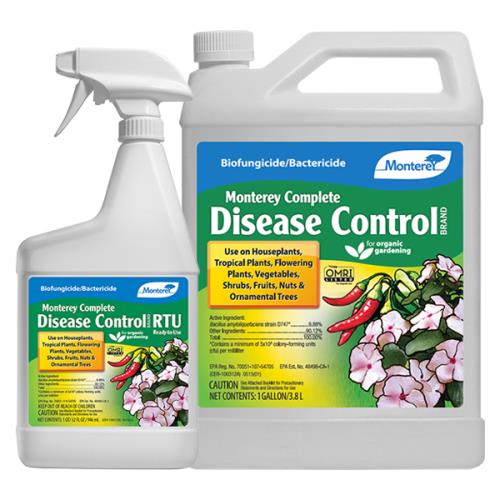
Monterey Complete Disease Control Comes as a Concentrate or Spray
but you may identify alternative products with the same active ingredient.
You can treat powdery mildew with a multitude of products. A long-standing favorite of mine for all powdery mildew is bicarbonate-based Green Cure. Unfortunately, the product is in short supply as the developer has retired. The good news is there are other organic treatments on the market. A simple web search will help you identify them.
As with most fungicides if you decide to treat, plan on reapplying every 7 to 10 days. Follow the instructions on the label for full info on how to use any product you choose.
REFRESH THE MULCH
If there are any fungal spores in the old mulch, you want to prevent them from re-activating. Replace it after clean-up to reduce the spread and future infections.
THIN OUT YOUR PLANT
Last, consider thinning out your plant at pruning time but not now. Any pruning you do now will be unfavorable to your plant so just don’t do it. This time of year, your plants are forming their buds for next year. You don’t want to redirect their energy.
Your objective when you thin it out is to open up your plant to allow air to circulate and leaves to dry. Over the course of the winter, you could do this thinning whenever your plant is dormant, i.e., has dropped all its leaves.
MORE INFO ON HYDRANGEA DISEASES
I devote an entire chapter to hydrangea diseases and insects in my internationally best selling book, Success With Hydrangeas, a Gardener’s Guide. Get yours HERE.

Success With Hydrangeas Book
In the meantime, enjoy this glorious fall season. Steamy hot days are gone for the most part. The panicle hydrangeas are blushed pink and rosy red now that night temps are cooler. The big leaf and mountain hydrangea flowers are transforming into green, lavender and other hues while the surrounding maples are going crimson. It all makes working in the garden a very pleasant activity.
HYDRANGEA PRUNING CLASS ON 9/26/21

Audience listening to speaker
My last NY Botanical Garden class for this year will be next Sunday, 9/26. Over the course of 2 hours, I will cover hydrangea pruning. Go HERE for the full details and to enroll.
Thanks for reading!
6 Secrets for Stunning Hydrangea Flowers
Get my FREE mini-guide with 6 fool-proof tips showing how to grow hydrangeas that produce the most amazing flowers.
No spam - I promise!
